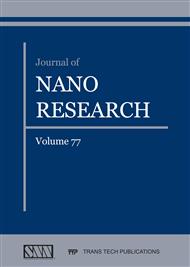[1]
T. Watcharatharapong, M. Minakshi Sundaram, S. Chakraborty, D. Li, G.M. Shafiullah, R.D. Aughterson, R. Ahuja, Effect of transition metal cations on stability enhancement for molybdate-based hybrid supercapacitor. ACS Applied Materials & Interfaces. 9 (2017) 17977-17991
DOI: 10.1021/acsami.7b03836
Google Scholar
[2]
A. Muzaffar, M.B. Ahamed, K. Deshmukh, J. Thirumalai, A review on recent advances in hybrid supercapacitors: Design, fabrication and applications. Renewable and Sustainable Energy Reviews. 101 (2019) 123-145
DOI: 10.1016/j.rser.2018.10.026
Google Scholar
[3]
B.K. Ostafiychuk, I.M. Budzulyak, B.I. Rachiy, V.M. Vashchynsky, V.I. Mandzyuk, R.P. Lisovsky, L.O. Shyyko, Thermochemically activated carbon as an electrode material for supercapacitors. Nanoscale Research Letters. 10 (2015) 1-8
DOI: 10.1186/s11671-015-0762-1
Google Scholar
[4]
X. Zhang, L. Wei, X. Guo, Ultrathin mesoporous NiMoO4-modified MoO3 core/shell nanostructures: enhanced capacitive storage and cycling performance for supercapacitors. Chemical Engineering Journal. 353 (2018) 615-625
DOI: 10.1016/j.cej.2018.07.160
Google Scholar
[5]
O.M. Popovych, I.M. Budzulyak, V.O. Kotsyubynsky, L.S. Yablon, O.V. Popovych, Electrochemical and electrical properties of nickel molybdate / carbon material composites. Physics and Chemistry of Solid State. 22 (2021) 481-486
DOI: 10.15330/pcss.22.3.481-486
Google Scholar
[6]
O.M. Popovych, I. M. Budzulyak, V.O. Kotsyubynsky, V.M. Boychuk, R.V. Ilnytskyi, M.M. Khemii, N.Ya. Ivanichok, Ye.V. Lezun, Ultrasonic modification of nanocrystalline NiMoO4 hydrate obtained by hydrothermal method. Physics and Chemistry of Solid State. 23 (2022) 341-346
DOI: 10.15330/pcss.23.2.341-346
Google Scholar
[7]
O.M. Popovych, I.M. Budzulyak, V.O. Yukhymchuk, S.I. Budzulyak, D.I. Popovych, Raman spectroscopy of nickel molybdate and its modifications. Fullerenes, Nanotubes and Carbon Nanostructures. 29 (2021) 1009-1015
DOI: 10.1080/1536383X.2021.1925253
Google Scholar
[8]
T. Brousse, D. Bélanger, J.W. Long, To be or not to be pseudocapacitive? Journal of The Electrochemical Society. 162 (2015) A5185
DOI: 10.1149/2.0201505jes
Google Scholar
[9]
N.R. Chodankar, H.D. Pham, A.K. Nanjundan, J.F.S. Fernando, K. Jayaramulu, D. Golberg, Y.-K. Han, D. P. Duba, True meaning of pseudocapacitors and their performance metrics: asymmetric versus hybrid supercapacitors. Small. 16 (2020) 2002806
DOI: 10.1002/smll.202002806
Google Scholar
[10]
A. Shameem, P. Devendran, V. Siva, R. Packiaraj, N. Nallamuthu, S. Asath Bahadur, Electrochemical performance and optimization of α-NiMoO4 by different facile synthetic approach for supercapacitor application. Journal of Materials Science: Materials in Electronics. 30 (2019) 3305-3315
DOI: 10.1007/s10854-018-00603-3
Google Scholar
[11]
M. Minakshi, D.R. Mitchell, A.R. Munnangi, A.J. Barlow, M. Fichtner, New insights into the electrochemistry of magnesium molybdate hierarchical architectures for high performance sodium devices. Nanoscale. 10 (2018) 13277-13288
DOI: 10.1039/C8NR03824D
Google Scholar
[12]
S. Motupally, C.C. Streinz, J.W. Weidner, Proton diffusion in nickel hydroxide films: measurement of the diffusion coefficient as a function of state of charge. Journal of the Electrochemical Society. 142 (1995) 1401
DOI: 10.1149/1.2048589
Google Scholar
[13]
B. Senthilkumar, R.K. Selvan, Hydrothermal synthesis and electrochemical performances of 1.7 V NiMoO4⋅ xH2O|| FeMoO4 aqueous hybrid supercapacitor. Journal of colloid and interface science. 426 (2014) 280-286
DOI: 10.1016/j.jcis.2014.04.010
Google Scholar
[14]
R. Ojani, J.B. Raoof, S.R.H. Zavvarmahalleh, Preparation of Ni/poly (1, 5-diaminonaphthalene)-modified carbon paste electrode; application in electrocatalytic oxidation of formaldehyde for fuel cells. Journal of Solid State Electrochemistry. 13 (2009) 1605-1611
DOI: 10.1007/s10008-008-0718-9
Google Scholar
[15]
P. Oliva, J. Leonardi, J.F. Laurent C. Delmas, J.J. Braconnier, M. Figlarz, F. Fievet, A. de Guibert, Review of the structure and the electrochemistry of nickel hydroxides and oxy-hydroxides. Journal of Power sources. 8 (1982) 229-255
DOI: 10.1016/0378-7753(82)80057-8
Google Scholar
[16]
A. Delahaye-Vidal, M. Figlarz, Textural and structural studies on nickel hydroxide electrodes. II. Turbostratic nickel (II) hydroxide submitted to electrochemical redox cycling. Journal of applied electrochemistry. 17 (1987) 589-599
DOI: 10.1007/BF01084134
Google Scholar
[17]
O.M. Hemiy, L.S. Yablon, I.M. Budzulyak, S.I. Budzulyak, O.V. Morushko, A.I. Kachmar, Electrochemical properties of nanocomposite nanoporous carbon / nickel hydroxide. Journal of Nano- and Electronic Physics. 8 (2016) 04074
DOI: 10.21272/jnep.8(4(2)).04074
Google Scholar
[18]
O.M. Khemii, I.M. Budzuliak, V.O. Kotsyubynsky, L.S. Yablon, R.V. Ilnytskyi, V.M. Boychuk, O.V. Morushko, Kh.V. Bandura and M.M. Khemii, Synthesis, morphology, electrical conductivity and electrochemical properties of α-Ni(OH)2 and its composites with carbon. Materials Science-Poland. 37 (2019) 547-553
DOI: 10.2478/msp-2019-0077
Google Scholar
[19]
X.J. Han, P. Xu, C.Q. Xu, L. Zhao, Z.B. Mo, T. Liu, Study of the effects of nanometer β-Ni(OH)2 in nickel hydroxide electrodes. Electrochimica Acta. 50 (2005) 2763-2769
DOI: 10.1016/j.electacta.2004.11.025
Google Scholar
[20]
D. Ghosh, S. Giri, C. K. Das, Synthesis, characterization and electrochemical performance of graphene decorated with 1D NiMoO4· nH2O nanorods. Nanoscale. 5(2013) 10428-10437
DOI: 10.1039/C3NR02444J
Google Scholar
[21]
H. Wan, J. Jiang, X. Ji, L. Miao, L. Zhang, K. Xu, H. Chen, Y. Ruan, Rapid microwave-assisted synthesis NiMoO4· H2O nanoclusters for supercapacitors. Materials Letters. 108 (2013) 164-167
DOI: 10.1016/j.matlet.2013.06.099
Google Scholar


